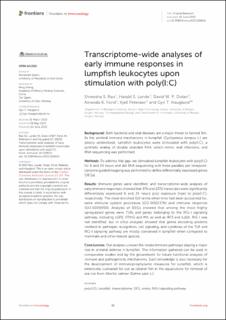| dc.contributor.author | Sadashiva Rao, Shreesha | |
| dc.contributor.author | Lunde, Harald Sæbø | |
| dc.contributor.author | Dolan, David William Peter | |
| dc.contributor.author | Fond, Amanda Kästel Sandal | |
| dc.contributor.author | Petersen, Kjell | |
| dc.contributor.author | Haugland, Gyri Teien | |
| dc.date.accessioned | 2024-01-17T09:50:16Z | |
| dc.date.available | 2024-01-17T09:50:16Z | |
| dc.date.created | 2023-08-30T09:07:25Z | |
| dc.date.issued | 2023 | |
| dc.identifier.issn | 1664-3224 | |
| dc.identifier.uri | https://hdl.handle.net/11250/3112073 | |
| dc.description.abstract | Background: Both bacterial and viral diseases are a major threat to farmed fish. As the antiviral immune mechanisms in lumpfish (Cyclopterus lumpus L.) are poorly understood, lumpfish leukocytes were stimulated with poly(I:C), a synthetic analog of double stranded RNA, which mimic viral infections, and RNA sequencing was performed.
Methods: To address this gap, we stimulated lumpfish leukocytes with poly(I:C) for 6 and 24 hours and did RNA sequencing with three parallels per timepoint. Genome guided mapping was performed to define differentially expressed genes (DEGs).
Results: Immune genes were identified, and transcriptome-wide analyses of early immune responses showed that 376 and 2372 transcripts were significantly differentially expressed 6 and 24 hours post exposure (hpe) to poly(I:C), respectively. The most enriched GO terms when time had been accounted for, were immune system processes (GO:0002376) and immune response (GO:0006955). Analysis of DEGs showed that among the most highly upregulated genes were TLRs and genes belonging to the RIG-I signaling pathway, including LGP2, STING and MX, as well as IRF3 and IL12A. RIG-I was not identified, but in silico analyses showed that genes encoding proteins involved in pathogen recognition, cell signaling, and cytokines of the TLR and RIG-I signaling pathway are mostly conserved in lumpfish when compared to mammals and other teleost species.
Conclusions: Our analyses unravel the innate immune pathways playing a major role in antiviral defense in lumpfish. The information gathered can be used in comparative studies and lay the groundwork for future functional analyses of immune and pathogenicity mechanisms. Such knowledge is also necessary for the development of immunoprophylactic measures for lumpfish, which is extensively cultivated for use as cleaner fish in the aquaculture for removal of sea lice from Atlantic salmon (Salmo salar L.). | en_US |
| dc.language.iso | eng | en_US |
| dc.publisher | Frontiers | en_US |
| dc.rights | Navngivelse 4.0 Internasjonal | * |
| dc.rights.uri | http://creativecommons.org/licenses/by/4.0/deed.no | * |
| dc.title | Transcriptome-wide analyses of early immune responses in lumpfish leukocytes upon stimulation with poly(I:C) | en_US |
| dc.type | Journal article | en_US |
| dc.type | Peer reviewed | en_US |
| dc.description.version | publishedVersion | en_US |
| dc.rights.holder | Copyright 2023 The Author(s) | en_US |
| dc.source.articlenumber | 1198211 | en_US |
| cristin.ispublished | true | |
| cristin.fulltext | original | |
| cristin.qualitycode | 1 | |
| dc.identifier.doi | 10.3389/fimmu.2023.1198211 | |
| dc.identifier.cristin | 2170720 | |
| dc.source.journal | Frontiers in Immunology | en_US |
| dc.identifier.citation | Frontiers in Immunology. 2023, 14, 1198211. | en_US |
| dc.source.volume | 14 | en_US |

